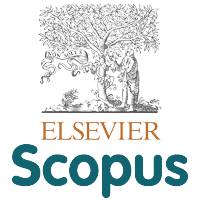THE POTENTIAL OF TREATED PALM OIL MILL EFFLUENT (POME) SLUDGE AS AN ORGANIC FERTILIZER
Abstract
Keywords
Full Text:
PDFReferences
APHA. 2005. Standard methods for the examination of water and wastewater, 20th edition. E.W. Rice, R.B. Baird, A.D. Eaton and L.S. Clesceri (eds.). Washington: American Public Health Association. p. 1200.
ASCE. 2009. Sustainable sludge management: Production of value added products. R.D. Tyagi, R.Y. Surampalli, S. Yan, T.C. Zhang, C.M. Kao and B.N. Lohani. Virginia: American Society of Civil Engineers Publication. p. 341.
Baharuddin, A.S., L.S. Hock, M.Z.Md. Yusof, N.A.A. Rahman, U.K.Md. Shah, M.A. Hassan, M. Wakisaka, K. Sakai and Y. Shirai. 2010. Effects of palm oil mill effluent (POME) anaerobic sludge from 500 m3 of closed anaerobic methane digested tank on pressed-shredded empty fruit bunch (EFB) composting process. African Journal of Biotechnology 9 (16): 2427-2436.
Bernal, M.P., J.A. Alburquerque and R. Moral. 2009. Composting of animal manures and chemical criteria for compost maturity assessment: A review. Bioresource Technology 100 (22): 5444-5453. crossref
Bhattacharya, S.K., R.L. Madura, D.A. Walling and J.B. Farrell. 1996. Volatile solids reduction in two-phase and conventional anaerobic sludge digestion. Water Research 30 (5): 1041-1048. crossref
Bigdeli, M. and M. Seilsepour. 2008. Investigation of metals accumulation in some vegetables irrigated with waste water in shahre rey-iran and toxicological implications. American-Eurasian Journal of Agricultural and Environmental Sciences 4 (1): 86-92.
Bolzonellaa, D., P. Pavan, P. Battistoni and F. Cecchi. 2005. Mesophilic anaerobic digestion of waste activated sludge: influence of the solid retention time in the wastewater treatment process. Process Biochemistry 40 (3-4): 1453-1460. crossref
Botheju, D. and R. Bakke. 2011. Oxygen effects in anaerobic digestion - a review. The Open Waste Management Journal 4: 1-19.
Cai, L., T.B. Chen, D. Gao, H.T. Liu, J. Chen and G.D. Zheng. 2013. Time domain reflectometry measured moisture content of sewage sludge compost across temperatures. Waste Management 33 (1): 12-17. crossref
Clark, W.M., A. Bansal, M. Sontakke and Y.H. Ma. 1991. Protein adsorption and fouling in ceramic ultrafiltration membranes. Journal of Membrane Science 55 (1-2): 21-38. crossref
CSSS. 2007. Soil sampling and methods of analysis, second edition. M.R. Carter and E.G. Gregorich (eds.). Canadian Society of Soil Science. Boca Raton: CRC Press. p. 1264.
EPA. 2000. Wastewater technology fact sheet: anaerobic lagoons. Environmental Protection Agency. http://nepis.epa.gov/Exe /ZyPDF.cgi/P100IL5S.PDF?Dockey=P100IL5S.PDF. Accessed on August 20, 2014. pp. 1-6.
Gillberg, L.,B. Hansen, I. Karlsson, A.N. Enkel and A. Palsson. 2003. About water treatment. Helsingborg: Kemira Kernwater. p. 220.
Gujer, W. 1980. The effect of particulate organic material on activated sludge yield and oxygen requirement. Progress in Water Technology 12: 79-95.
Hachicha, S., F. Sellami, J. Cegarra, R. Hachicha, N. Drira, K. Medhioub and E. Ammar. 2009. Biological activity during co-composting of sludge issued from the OMW evaporation ponds with poultry manure-Physico-chemical characterization of the processed organic matter. Journal of Hazardous Materials 162 (1): 402-409. crossref
Hubbe, M.A., M. Nazhad and C. Sanchez. 2010. Composting as a way to convert cellulosic biomass and organic waste into high-value soil amendments: a review. BioResources 5 (4): 2808-2854.
Hulshoff, P.L.W. 1995. Waste characteristics and factors affecting reactor performance: 1. Process factors, waste characterisation and pH related toxicity. In: International course on Anaerobic Treatment, 17-28 July 1995. Wageningen: Wageningen Agricultural University/IHE Delft.
Jouraiphy, A., S. Amir, M. El Gharous, R. Jean-Claude and M. Hafidi. 2005. Chemical and spectroscopic analysis of organic matter transformation during composting of sewage sludge and green plant waste. International Biodeterioration & Biodegradation 56 (2): 101-108. crossref
Kobya, M., E. Senturk and M. Bayramoglu. 2006. Treatment of poultry slaughterhouse wastewaters by electrocoagulation. Journal of Hazardous Materials 133 (1-3): 172-176. crossref
Li, B. and G. Wu. 2014. Effects of sludge retention times on nutrient removal and nitrous oxide emission in biological nutrient removal processes. International Journal of Environmental Research and Public Health 11 (4): 3553-3569. crossref
Mata-Alvarez, J. 2003. Biomethanization of the organic fraction of municipal solid wastes. London: IWA Publishing. p. 317.
Nutongkaew, T., W. Duangsuwan, S. Prasertsan and P. Prasertsan. 2014. Physicochemical and biochemical changes during composting of different mixing ratios of biogas sludge with palm oil mill wastes and biogas effluent. Journal of Material Cycles and Waste Management 16 (1): 131-140. crossref
Presertsan, S. and P. Prasertsan. 1996. Biomass residues from palm oil mills in Thailand: An overview on quantity and potential usage. Biomass and Bioenergy 11 (5): 387-395. crossref
Rajeshwari, K.V., M. Balakrishnan, A. Kansal, K. Lata and V.V.N. Kishore. 2000. State-of-the-art of anaerobic digestion technology for industrial wastewater treatment. Renewable and Sustainable Energy Reviews 4 (2): 135-156. crossref
Richards, B.K., T.S. Steenhuis, J.H. Peverly and M.B. McBride. 2000. Effect of sludge-processing mode, soil texture and soil pH on metal mobility in undisturbed soil columns under accelerated loading. Environmental Pollution 109 (2): 327-346. crossref
Sharma, J. and R. Singh. 2001. Effect of nutrients supplementation on anaerobic sludge development and activity for treating distillery effluent. Bioresource Technology 79 (2): 203-206. crossref
Sharma, R.K., M. Agrawal and F. Marshall. 2007. Heavy metal contamination of soil and vegetables in suburban areas of Varanasi, India. Ecotoxicology and Environmental Safety 66 (2): 258-266. crossref
Singh, R.P., M.H. Ibrahim, N. Esa and M.S. Iliyana. 2010. Composting of waste from palm oil mill: a sustainable waste management practice. Reviews in Environmental Science and Bio/Technology 9 (4): 331-344. crossref
Sunada, N.daS., A.C.A. Orrico, M.A.P. Orrico jr., F.M. de Vargas jr., R.G. Garcia and A.R.M. Fernandes. 2012. Potential of biogas and methane production from anaerobic digestion of poultry slaughter house effluent. Revista Brasileira de Zootecnia 41 (11): 2379-2383. crossref
Texier, P. 2008. Effect of acidification on sludge dewatering properties. Annee 2007-2008. pp. 78-85.
Tumuhairwe, J.B., J.S. Tenywa, E. Otabbong and S. Ledin. 2009. Comparison of four low technology composting methods for market crop wastes. Waste Management 29 (8): 2274-2281. crossref
Wan Razali, W.A., A.S. Baharuddin, A.T. Talib, A. Sulaiman, M.N. Naim, M.A. Hassan and Y. Shirai. 2012. Degradation of oil palm empty fruit bunches (OPEFB) fibre during composting process using in-vessel composter. BioResources 7 (4): 4786-4805.
Wong, K.M., N.A.A. Rahman, S.A. Aziz, V. Sabaratnam and M.A. Hassan. 2008. Enzymatic hydrolysis of palm oil mill effluent solid using mixed cellulases from locally isolated fungi. Research Journal of Microbiology 3 (6): 474-481. crossref
Yan, Z., J. Jiang and M. Chen. 2008. MINTEQ modeling for evaluating the leaching behavior of heavy metals in MSWI fly ash. Journal of Environmental Sciences 20 (11): 1398-1402. crossref
Yaser, A.Z., R.A. Rahman and M.S. Kalil. 2007. Co-composting of palm oil mill sludge-sawdust. Pakistan Journal of Biological Sciences 10 (24): 4473-4478.
Zhang, Q.H., X. Lu, L. Tang, Z.G. Mao, J.H. Zhang, H.J. Zhang and F.B. Sun. 2010. A novel full recycling process through two-stage anaerobic treatment of distillery wastewater for bioethanol production from cassava. Journal of Hazardous Materials 179 (1-3): 635-641. crossref
Zitomer, D.H. and J.D. Shrout. 1998. Feasibility and benefits of methanogenesis under oxygen-limited conditions. Waste Management 18 (2): 107-116. crossref
DOI: http://doi.org/10.17503/agrivita.v38i2.753
Copyright (c) 2016 AGRIVITA Journal of Agricultural Science
License URL: http://creativecommons.org/licenses/by-nc/4.0/








